Jeremy Morales, Cristina Hernandez, B.S., Claudia M. Toledo-Corral, Ph.D., Department of Health Sciences, California State University, Northridge, Northridge, CA
Research shows that psychosocial stressors have a deleterious effect on a wide range of mental and physical health outcomes. Specifically, constant exposure to elevated levels of stress can affect behavior by decreasing physical activity/exercise and increasing sedentariness. Racial and ethnic minorities present worse health than White Americans due to disparities that stem from discrimination, socioeconomic status, and environmental and acculturative stressors. The objective is to study the association between physical activity and stress among a population at risk for type 2 diabetes. Among a population of young adult college students, the “Metabolic Stress Assessment (MeSA) study is examining biologic stress responses to the hypothalamic-pituitary-adrenal axis, and the inherent risk for type 2 diabetes (target n=100). The MeSA study uses various surveys to measure categories of stress college students within the population may be experiencing. This includes categories like psychosocial stress (perceived stress, academic, everyday discrimination and neighborhood stress) and environmental exposures (noise, air, tobacco exposure). For this analysis, the International Physical Activity Questionnaire (IPAQ) was used to measure physical activity and perceived stress was measured by the Perceived Stress Scale (PSS) 10-item. Currently, the MeSA study has 16 women and 8 men enrolled in the study (n=24, mean age: 21+/-1.1 yrs) with a racial/ethnic distribution of 57% Hispanic, 21% Asian, and 22% other. Preliminary results show that using the IPAQ, those in the lower physical activity group have a higher mean PSS compared to those in the high physical activity group (mean 20.6+/-1.6 vs 17.8+/-1.8, p=0.217). When using a standalone question on physical activity and sedentary behavior, initial results present that those in the lowest physical activity and highest sedentary behavior group had a higher PSS score compared to those in the highest physical activity group (mean 23+/-2.9 vs 17+/-2.1, p=0.385). As the MeSA study increases the population size, we hypothesize that higher perceived stress and other stressors will associate with lower physical activity and more sedentariness. Supplementary future aims will be to examine specific populations like Asian and Hispanic racial/ethnic groups, populations of whom are at increasing risk for obesity and type 2 diabetes.
*This poster was presented at The American Psychosomatic Society annual meeting. The sample size reflects that of March 2020.
